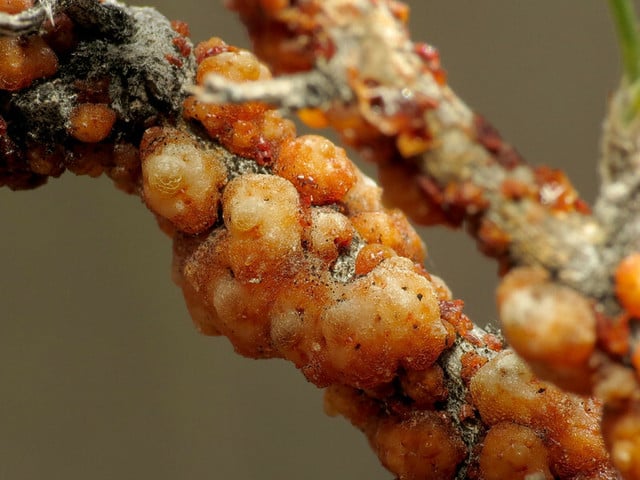Shellac is found in everyday products like furniture polish and food glazes — and it’s made using insect secretions. Here’s what you need to know.
The rise in veganism has sparked discussions about the compatibility of various ingredients with a vegan lifestyle. One such ingredient, shellac (uncapitalized), is found in everyday products like furniture finishes and candy coatings. Its vegan status can be a source of confusion.
Making matters even murkier, Shellac (capitalized) is also the name of a popular nail polish brand.
In this article, we’ll clear up the confusion and address the question: is shellac vegan? To understand the issue, we’ll need to look at the insect angle of this seemingly harmless ingredient.
What is Shellac?

(Foto: CC0 / Katja Schulz / Flickr)
Shellac, also known as “lac resin” or “E904,” is a resinous substance derived from the secretions of the lac beetle, primarily found on trees in Southeast Asia. The lac beetle, scientifically known as Kerria lacca, forms a symbiotic relationship with certain trees such as Palash, plum and Kusum trees. The lac harvested from Kusum trees is particularly valued for its wax-free consistency and golden hue.
The production process of shellac begins when female lac insects produce a resin to create protective cocoons for their eggs. The extraction of shellac involves carefully collecting the resin once the female lac insects leave their nests. Each kilogram of shellac requires an astonishing number of lac bugs, ranging from 50,000 to 300,000 insects. It is estimated that approximately 20,000 tons of shellac are produced worldwide.
This method of obtaining shellac, relying on the labor of lac insects and their secretions, raises ethical concerns within the vegan community. Furthermore, the significant number of insects involved in the process, coupled with the potential disruption to their natural habitats, raises questions about the compatibility of shellac with a vegan lifestyle.
Is Shellac Vegan?



(Foto: CC0 Public Domain / pexels - adrienne andersen)
Like honey, beeswax and silk, shellac is not considered vegan due to its origin from the natural secretions of the lac beetle. The process of harvesting shellac involves scraping off flakes of resin, causing harm to the beetles. This raises ethical concerns and renders shellac incompatible with cruelty-free principles.
Additionally, the production of shellac can involve employing workers in unregulated factories, facing low wages and unsanitary conditions. These factors contribute to broader ethical considerations surrounding shellac production. But what about shellac nail polish?
Does CND Shellac Nail Polish Contain Actual Shellac?
CND Shellac doesn’t include any shellac in its formula. It appears that the brand uses the word “Shellac” mainly for marketing because it is associated with high gloss and protective properties — ideal qualities in a manicure!
How is Shellac Used?



(Foto: CC0 Public Domain / Unsplash - amit lahav)
Shellac finds its way into a wide range of industries and everyday products, and spotting it isn’t always easy. Its presence can be unexpected, even extending to gummy bears. Understanding the common uses of shellac is essential when seeking alternatives that align with cruelty-free and or plant-based principles.
One prominent industry where shellac is used is the furniture industry. It serves as a versatile and durable natural resin, providing a glossy finish and protective coating for wooden furniture pieces. Shellac’s use in furniture finishes offers a traditional and time-tested solution — but if you see resin or polish listed in paints or varnishes, chances are it is derived from insects and is not vegan.
In the world of food and beverages, shellac plays a role as a food glaze and coating. It lends a shiny appearance to confectionery items like candies, chocolates and jelly beans. Additionally, shellac is used to give a glossy finish to certain fruits and vegetables — like citrus fruits — enhancing their visual appeal. Shellac used in food and candy is sometimes labeled E904, confectioner’s glaze or resinous glaze.
Shellac is also found in the pharmaceutical industry, where it serves as a coating for pills and tablets. This coating helps in controlled release and protects the medication from moisture and degradation.
While shellac has found its place across many industries, vegan consumers seek alternatives that align with their values. Fortunately, there are alternatives available for different applications, including plant-based waxes, natural resins and synthetic coatings.
Is Shellac Vegan? No, But Here Are Shellac Alternatives
For those seeking alternatives to shellac that don’t contain animal byproducts, there are a few options available offering comparable advantages. Here are some common alternatives to consider:
- Plant-Based Waxes: Plant-based waxes like carnauba wax, derived from the leaves of the carnauba palm, can be used as a substitute for shellac in certain applications. Carnauba wax is known for its glossy finish and protective properties, making it a viable alternative for furniture polishes and wood coatings. Homemade furniture polish is another wallet-friendly and sustainable option.
- Natural Resins: Natural resins such as dammar resin, derived from certain trees, can provide a similar protective coating and glossy finish to shellac. These resins offer alternatives for applications like varnishes and paints.
- Water-Based Coatings: Water-based coatings, including water-based varnishes and paints, have gained popularity as eco-friendly alternatives to solvent-based products. These coatings are often formulated without the use of animal-derived ingredients, making them suitable choices for vegan consumers.
- Synthetic Coatings: Synthetic coatings, made from non-animal-derived materials, offer a wide range of options. These coatings can provide durability, gloss and protective properties without relying on insect-derived substances.
Read more:
- How to Clean Fruit to Remove Wax and Chemicals
- What Is Glue Made Of? And Is It Vegan?
- 5 Zero-VOC Paints to Keep Toxic Fumes Out of Your Home
- Mica in Makeup: The Problematic Mineral That Makes You Sparkle
Do you like this post?









